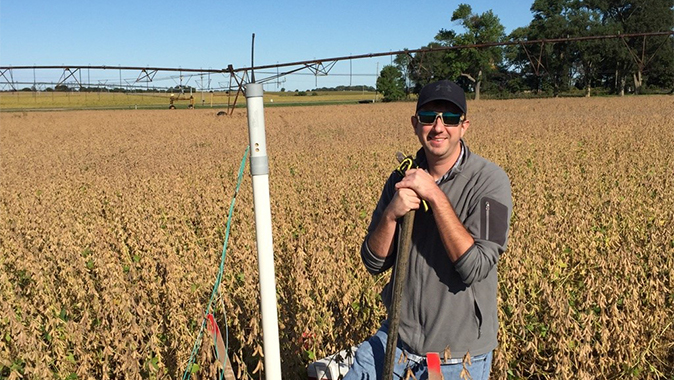
If you could produce the same amount of food with fewer resources, wouldn’t you?
That is the goal of new research led by Justin Gibson, a PhD student in the University of Nebraska–Lincoln’s School of Natural Resources and a Robert B. Daugherty Water for Food Global Institute student support grantee.
Gibson and several of the institute’s Faculty Fellows recently published a paper examining corn irrigation patterns in western Nebraska and their implications for water managers. The research shows reduced pumping water savings models for various irrigation scheduling strategies and offers recommendations for hyper-resolution land surface modeling to aid irrigation decision-making.
“We are interacting with producers out in the field, helping them understand how they can use less water to produce the same amount of food,” Gibson said.
Gibson presented the project at the 2016 Water for Food Global Conference and earned second place in the institute’s poster competition.
UNL hydrogeophysicst and DWFI Faculty Fellow Trenton Franz is also involved with the project.
“There are no yield impacts from a widely used crop model,” Franz said. “That means water managers can evaluate the economics of investing in such technologies and the likely water savings versus the cost of implementing the technology.”
The research helps inform how much water is necessary to produce irrigated corn, Gibson said. It allows researchers to test different scenarios, such as climate impacts or new irrigation policies.
The researchers came up with four plausible irrigation algorithms using weather data, soil information and more to recreate a historical irrigation time series. Their findings show that as the level of technology increases, the pumping savings also increase.
We saw that you could reduce pumping by nearly 30 percent without significantly hurting yield, Gibson said.
“That is an important consideration because the irrigation savings may not be worth it to farmers if they are losing yield,” Gibson said. “But if you aren’t impacting yield, that’s just free money sitting on the table.”
In the paper, the researchers state that the human use of water for irrigation is often ignored or poorly represented in land surface models and operational forecasts.
“As we face an ever-changing climate, we need to be agile and nimble in our efforts to produce food with limited resources,” said Gibson.
The research was published Feb. 20 in the Journal of Hydrology and Earth System Sciences as a special issue in honor of Eric F. Wood, “Observations and Modeling of Land Surface Water and Energy Exchanges Across Scales.” In addition to Gibson and Franz, co-authors include Tiejun Wang, John Gates, Patricio Grassini, Haishun Yang and Dean Eisenhauer. Read more on the study here.
Nam Tran, Daugherty Water for Food Global Institute intern
More details at: http://waterforfood.nebraska.edu/